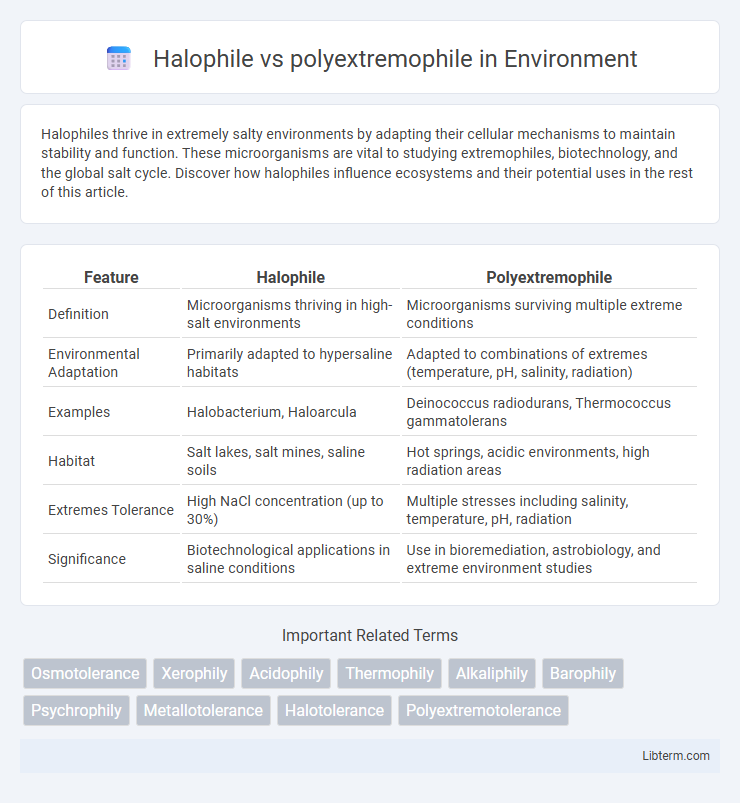Halophiles thrive in extremely salty environments by adapting their cellular mechanisms to maintain stability and function. These microorganisms are vital to studying extremophiles, biotechnology, and the global salt cycle. Discover how halophiles influence ecosystems and their potential uses in the rest of this article.
Table of Comparison
| Feature | Halophile | Polyextremophile |
|---|---|---|
| Definition | Microorganisms thriving in high-salt environments | Microorganisms surviving multiple extreme conditions |
| Environmental Adaptation | Primarily adapted to hypersaline habitats | Adapted to combinations of extremes (temperature, pH, salinity, radiation) |
| Examples | Halobacterium, Haloarcula | Deinococcus radiodurans, Thermococcus gammatolerans |
| Habitat | Salt lakes, salt mines, saline soils | Hot springs, acidic environments, high radiation areas |
| Extremes Tolerance | High NaCl concentration (up to 30%) | Multiple stresses including salinity, temperature, pH, radiation |
| Significance | Biotechnological applications in saline conditions | Use in bioremediation, astrobiology, and extreme environment studies |
Introduction to Extremophiles
Extremophiles are organisms that thrive in conditions considered hostile to most life forms, including extreme temperature, pH, salinity, and radiation. Halophiles are a specific group of extremophiles that flourish in high-salinity environments such as salt lakes and saline soils, employing unique cellular mechanisms to maintain osmotic balance. Polyextremophiles endure multiple extreme conditions simultaneously, such as high salinity combined with extreme temperature or acidity, showcasing versatile adaptations that provide insights into microbial resilience and potential biotechnological applications.
Defining Halophiles
Halophiles are microorganisms that thrive in environments with extremely high salt concentrations, typically above 3.5% sodium chloride. These organisms adapt through specialized cellular mechanisms such as salt-in strategies and compatible solute accumulation to maintain osmotic balance and enzyme functionality. Unlike polyextremophiles, which endure multiple extreme conditions like temperature, pH, and salinity, halophiles are specifically adapted to saline habitats such as salt lakes, saline soils, and salt mines.
Characteristics of Polyextremophiles
Polyextremophiles exhibit remarkable resilience by thriving under multiple extreme conditions simultaneously, such as high salinity, extreme temperatures, and intense radiation. Unlike halophiles, which are specialized to survive mainly in hypersaline environments, polyextremophiles possess adaptive mechanisms including robust DNA repair systems, specialized protein folding, and membrane stability that enable survival across diverse and harsh habitats. These organisms offer insights into biotechnological applications due to their unique enzymes and metabolic pathways suited for extreme environmental stressors.
Environmental Niches: Where They Thrive
Halophiles thrive in hypersaline environments such as salt lakes, saline soils, and salt evaporation ponds where salt concentrations often exceed 20%. Polyextremophiles occupy multiple extreme niches simultaneously, including environments with high salinity, extreme temperatures, acidic pH, or radiation, such as deep-sea hydrothermal vents and acidic salt flats. These adaptive traits enable polyextremophiles to succeed in complex habitats that combine several harsh conditions, unlike halophiles which specialize primarily in high-salt niches.
Molecular Adaptations in Halophiles
Halophiles exhibit molecular adaptations such as the accumulation of compatible solutes like potassium ions and specialized proteins with acidic surfaces to maintain stability and function in high-salt environments. Polyextremophiles combine multiple adaptations to survive extreme conditions, but halophiles specifically optimize ion transport and protein folding mechanisms for osmotic balance. Understanding these molecular strategies highlights the unique evolutionary pathways enabling halophiles to thrive in hypersaline habitats.
Survival Strategies of Polyextremophiles
Polyextremophiles survive by simultaneously coping with multiple extreme conditions such as high salinity, temperature fluctuations, and radiation through complex molecular adaptations including specialized enzymes and protective cellular structures. In contrast, halophiles primarily thrive in hypersaline environments by employing salt-in strategies and compatible solute accumulation to maintain osmotic balance. The polyextremophiles' multidimensional resilience showcases evolutionary optimization for diverse, harsh habitats beyond the singular niche adaptation seen in halophiles.
Comparative Genomics: Halophiles vs Polyextremophiles
Comparative genomics reveals that halophiles possess specialized genes encoding for salt-tolerant proteins and osmoprotectant synthesis, enabling survival in hypersaline environments. Polyextremophiles exhibit a broader genetic repertoire, including multiple stress response genes for diverse challenges such as heat, radiation, and desiccation, reflecting their adaptation to multiple extreme conditions. Genomic analyses highlight unique regulatory networks and DNA repair mechanisms in polyextremophiles compared to the more specialized adaptations observed in halophiles.
Industrial and Biotechnological Applications
Halophiles thrive in high-salt environments, producing salt-tolerant enzymes useful in industries like food processing, bioremediation, and biofuel production. Polyextremophiles withstand multiple extreme conditions such as salinity, temperature, and pH, enabling biotechnological applications in harsh industrial processes including pharmaceuticals, waste treatment, and chemical synthesis. Their unique metabolites and enzymes offer robust alternatives for sustainable industrial biotechnology, enhancing efficiency and resilience in various bioprocesses.
Ecological and Evolutionary Significance
Halophiles, specialized for high-salinity environments, drive essential nutrient cycling and contribute to the stability of hypersaline ecosystems, demonstrating unique osmoadaptation mechanisms that highlight evolutionary innovation. Polyextremophiles exhibit resilience to multiple extreme conditions such as temperature, pH, and salinity, promoting genetic diversity and fostering ecological niches that support complex microbial communities. Their adaptations reveal evolutionary pathways for survival in multifaceted habitats, informing biotechnological applications and the search for extraterrestrial life.
Future Research Directions
Future research on halophiles emphasizes genetic engineering to enhance salt tolerance in crops and industrial microbes, leveraging their unique adaptations to hypersaline environments. Polyextremophiles offer insights into biomolecules resilient to multiple stresses, guiding the development of robust biocatalysts for pharmaceuticals and biofuels under extreme conditions. Integrative omics and synthetic biology approaches aim to unravel the complex regulatory networks in these extremophiles, enabling tailored applications in biotechnology and astrobiology.
Halophile Infographic

 libterm.com
libterm.com